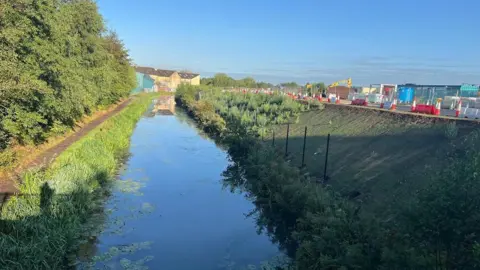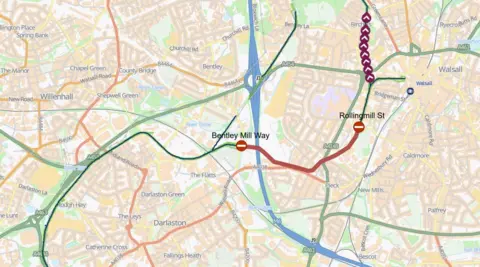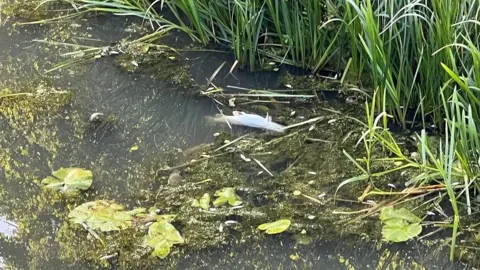 BBC
BBCThe Environment Agency (EA) has said about 4,000 litres (879 gallons) of toxic chemicals were released into a canal in the West Midlands.
Tests have been carried out on a 12-mile stretch of the canal from Walsall locks to the lock flights at Rushall/Ryders Green and Perry Barr.
People will now be allowed to return to parts of the waterway and towpaths in the affected area, which have been closed since Monday.
A 1km (0.6 mile) section of the canal between James Bridge on Bentley Mill Way and Rollingmill Street would remain closed after high levels of chemicals including sodium cyanide and zinc cyanide were found, the council said.
The substances were released into the canal after what the EA called a waste disposal incident at Anochrome Ltd.
 Walsall Council
Walsall CouncilLaboratory tests revealed water quality was within public health guidelines in significant stretches of the canal, according to the council.
They added normal activities could resume in the reopened areas but as a precaution people were warned not to eat fish from the canal.
Testing will continue in the stretch that remains closed.
The EA said a timescale for when the chemicals would be fully removed could not be confirmed as teams were working to understand the concentration levels.

Marc Lidderth, from the agency, said laboratory results showed the chemicals had not gone as far within the canal network as initially feared.
There were still chemicals within the 1km (0.62 miles) stretch of canal at Reservoir Place, he added.
Academics had previously suggested that the contamination was likely to have been contained in the area – more so than if the spill had occurred in a faster-flowing waterway like a river.
“With regards to the canal network that has reopened, public health, Walsall Council and the UK Health Security Agency have deemed that safe,” Mr Lidderth said.
“It’s below the public health guidelines so any event and festivals that are taking place on those stretches that have reopened will be safe for the public to use.”
Organisers of the Brownhills Canal Festival confirmed on Thursday their event was still scheduled to go ahead on Saturday and Sunday.

About 100 dead fish have been seen floating on the surface of the canal near Reservoir Place.
The EA installed a temporary dam across the canal on Thursday as a physical barrier to block off the contaminated section.
Arrangements have also been made for boaters who wish to leave the area, the council said.
An investigation into the cause of the spillage was continuing with the issue having been declared a major incident by the West Midlands Resilience Forum, comprising three local councils, health agencies, police, fire service and organisations responsible for water and waterways.
Mr Lidderth said the EA was carrying out a thorough investigation and working on-site at Anochrome Ltd, which deals in surface coatings and sealing, after the firm said it “regrettably” released the chemicals.
“We are looking at everything that has happened around that cause and will be working with them to make sure that something like this doesn’t happen again,” he said.
What is sodium cyanide?
- The chemical sodium cyanide is a white crystal-like solid with a faint almond odour
- It is used in industry for metal cleaning, plating and extraction
- When cyanide salts are swallowed they release cyanide in the body – they can also be absorbed through the skin
- Expose can cause symptoms including headaches, nausea, dizziness, loss of consciousness, seizures and vomiting
- It can be rapidly fatal if inhaled or ingested as it interferes with the body’s ability to use oxygen
(Source: UK Health Security Agency)
Sodium cyanide dissolves in water and can have serious adverse health effects if people or pets come into direct contact with it, the council advised.
Anyone who has had direct physical contact with water along the affected stretch of the canal and is feeling unwell, should seek health advice via 111 or 999 in an emergency, a spokesperson for the authority added.


